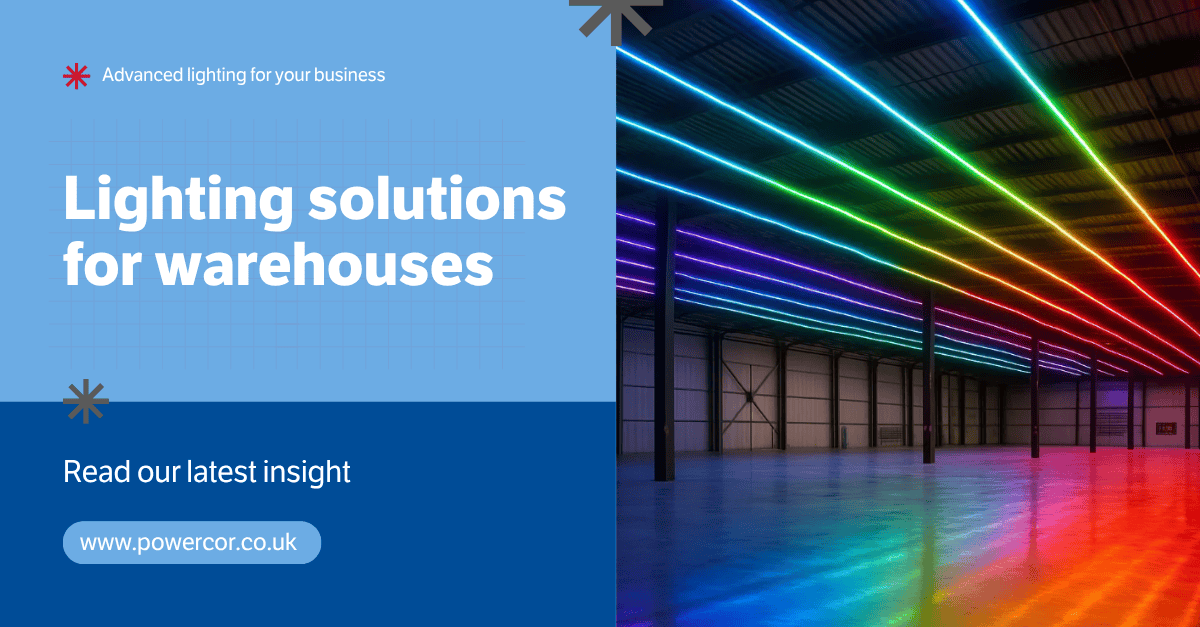For warehouse operators across the UK, and efficient lighting system is a strategic asset. Smart lighting solutions tailored to large-scale, high-ceiling environments are not only essential for safety and productivity, but they also unlock major savings in operational costs and carbon footprint. For a company like Powercor, offering integrated, future-ready lighting systems for warehouses is a clear route to differentiation and client value.
Outdated systems can bleed money
Traditional high-intensity discharge (HID) fixtures or fluorescent lighting are common across UK warehouses. They’re inefficient, slow to respond, and expensive to maintain. These legacy systems often operate at full output regardless of daylight levels or occupancy, driving energy bills through the roof. In high-bay environments, replacing bulbs is a costly and disruptive task—one that smarter lighting systems drastically reduce or eliminate.
LED retrofitting remains the most immediate win for most warehouses. Swapping out legacy fittings for modern, high-efficiency LEDs can cut lighting energy use by 60–80%. But the real step change comes with smart controls.
Intelligent lighting adapts to the space
Smart lighting controls and solutions are transforming warehouse operations. Systems integrated with motion sensors, ambient light detection, and programmable zones allow lighting to respond dynamically to what’s happening in the space. In low-traffic areas or during quiet periods, lights dim or switch off automatically. In active zones, brightness adjusts to ensure safety and visibility.
Daylight harvesting is an especially powerful feature. Many modern warehouses are equipped with skylights or translucent roofing, yet without sensors to detect natural light levels, electric lighting continues to operate at full power. Smart systems monitor lux levels in real time and adjust output accordingly, achieving seamless energy savings without affecting the working environment.
Zonal control and IoT integration
Zonal lighting is crucial for large-scale sites. Dividing a warehouse into programmable lighting zones allows site managers to customise lighting levels based on operational requirements, shift schedules, or safety priorities. Loading bays, picking lines, storage aisles, and office annexes can all be individually optimised.
Integrating lighting with broader IoT infrastructure enhances this control further. Occupancy sensors, asset tracking, temperature monitoring, and energy metering can all feed into a central system. Bespoke lighting solutions for warehouses should be part of a wider smart building architecture, providing not just illumination, but actionable data on usage patterns, maintenance alert, and energy anomalies.
Emergency and compliance-ready by design
Lighting in warehouses isn’t just about operational efficiency; it’s also a compliance requirement. Emergency lighting, escape route illumination, and signage lighting must meet stringent UK safety standards. With modern lighting systems, these can be embedded into the overall control architecture. Automated testing and self-diagnosis for emergency fittings simplify compliance, reduce admin burdens and help to satisfy the risk management demands of insurance companies.
Sustainability sells, and saves
Warehouse operators are under pressure to cut carbon, both from regulators and their own supply chains. Lighting represents a key area for decarbonisation. By combining LED retrofits with smart control systems and IoT metering, Powercor can deliver measurable CO₂ reductions for warehouse operators, and provide data to back it up.
Lighting-as-a-service (LaaS) is a consideration for warehouse operators. Under an LaaS model, a company like Powercor can design, install, and maintains the lighting system, with clients paying a monthly fee that’s often offset by energy savings. This model eliminates capex barriers and ensures optimal performance over time.
Lighting solutions for warehouses are not static products, they’re living systems that must evolve with the site. Operators must consider upgrades, software patches, and integration with new tech as it emerges to stay ahead of regulation, competition, and cost pressure.
For warehouse operators, lighting upgrades deliver one of the fastest returns on investment available in facilities management. With short payback periods and immediate safety gains, smart lighting is a no-brainer.
FAQs
1. How can warehouse lighting support shift-based operations and workforce wellbeing?
Smart lighting systems can be programmed to match circadian rhythms, supporting worker alertness during night shifts and reducing fatigue. Adjustable colour temperatures and dimmable zones help create a more comfortable, productive work environment.
2. What are the cybersecurity risks of IoT-connected lighting in warehouses?
Connected lighting systems must be secured against cyber threats. Vulnerabilities in IoT infrastructure can be exploited if systems lack proper encryption, access controls, or updates. Secure design and regular audits are essential for operational resilience.
3. Can warehouse lighting systems support predictive maintenance strategies?
Yes. Advanced lighting platforms collect data on usage patterns and performance, which can be used to schedule maintenance before failures occur. This reduces downtime and extends the lifespan of critical infrastructure.
4. How does smart lighting interact with warehouse automation systems?
Lighting can be integrated with automated guided vehicles (AGVs), robotics, and inventory systems. For example, lights can activate only in areas where automated activity is taking place, supporting energy efficiency and improving visual clarity for sensors and cameras.
5. Are there financial incentives or tax reliefs for upgrading warehouse lighting in the UK?
Yes. Schemes such as the Enhanced Capital Allowance (ECA) for energy-efficient equipment and local authority grants can support lighting upgrades. These incentives help reduce payback periods and improve the ROI of energy-saving projects.







